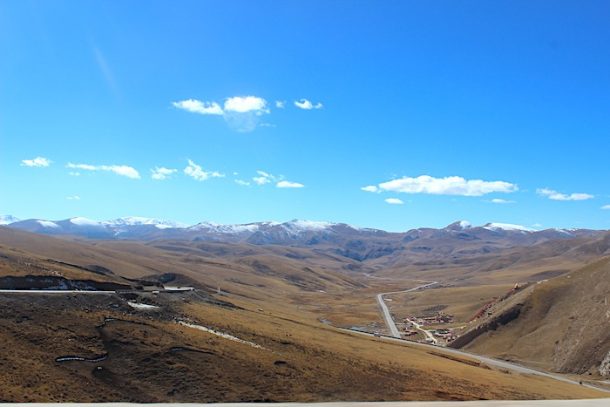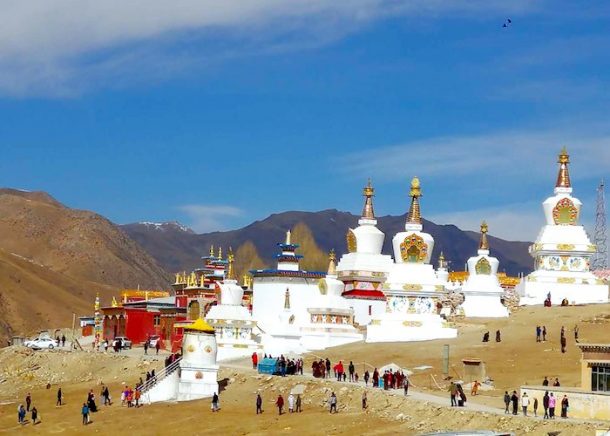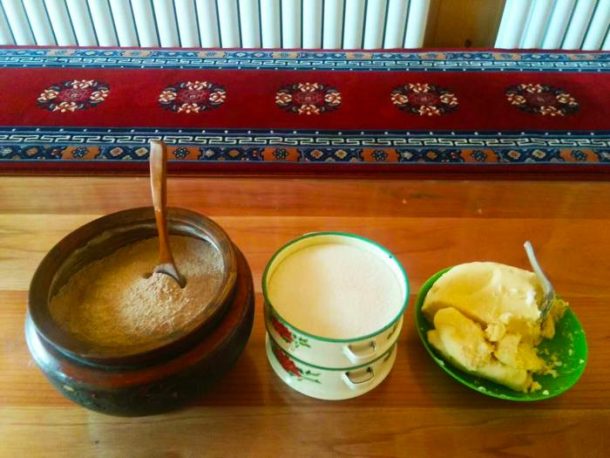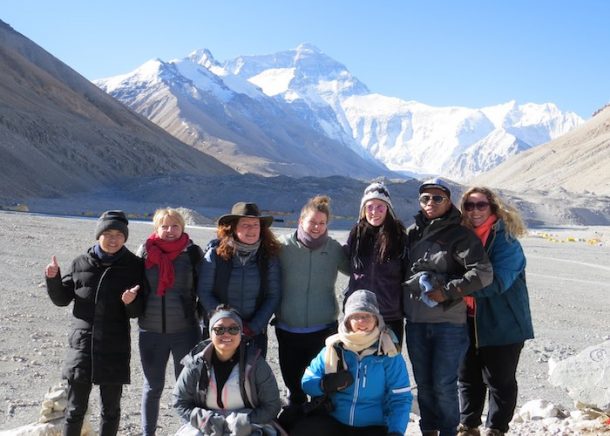
Is Tibet Worth Visiting?
Tibet has scenery worthy of any National Geographic FrontPage. It is the land of high-altitude Snow Mountains, stunning crystal-clear turquoise lakes, ancient monasteries, and lush valleys. Vast plains stretch out for hundreds of kilometers in all directions.
The homes of the world’s rarest wildlife like wild asses, rare Tibetan antelopes, and the wild yaks are the progenitors of the modern domesticated hybrids called “yaks” in Tibet these days. The unique Tibetan people are friendly and pleasant, devoted to their unique version of Buddhism.
It has been the main religion on the plateau for more than 1,300 years. And if that was not enough to get you wondering how to get to Tibet, then you should know that it is the best place to go for viewing the world’s highest mountain, Mount Everest, at close quarters.
Table of Contents
How big is Tibet?
Tibet is known variously as “The Roof of the World,” “The Land of Snows,” and “The Third Pole.” It is a vast place, despite appearing to be dwarfed by the rest of China. At around two-thirds the size of Western Europe.

Tibet is a colossal place to visit, and travelers can spend days getting from one place to another. And that is just the area known as the Tibet Autonomous Region. But the ancient Tibetan Empire stretched far into the modern-day Chinese provinces of Qinghai, Sichuan, Gansu, and Yunnan Provinces of China.
Tibetan autonomous prefectures now exist in these provinces. With a unique history that dates back thousands of years. Tibet is undoubtedly one of the most awe-inspiring places to travel to.
A Photographer’s Paradise
The landscape of Tibet and the people, buildings, and just about everything else are automatically very photogenic. While Switzerland and maybe New Zealand may come close to having landscapes and scenery that can almost equal that of the plateau. Tibet has a deeper and wilder aspect that makes it the most breathtakingly beautiful place on the planet.
Dramatic white clouds drift across an azure-blue sky and reflected perfectly in crystal clear lakes of turquoise waters. These are surrounded by immense mountains that spear the skies, with the vast and ancient glaciers carving grooves in their even older flanks. And all this is before you even visit the Great Three Holy Lakes of Tibet.
Everywhere you travel to Tibet, you will face one of the most stunning potential photographs you have ever imagined. Take a walk around the forbidden city of Lhasa, the Tibetan capital. You will come across the landmark of Lhasa, the Potala Palace,
It is the most sacred temple in Buddhism. Built-in the 7th century, this ancient Buddhist shrine is the perfect backdrop for the throngs of devoted Tibetan Buddhists who make their way around the “kora” route, a religious prayer pilgrimage, often culminating with hundreds of prostrations in front of the gates of the Jokhang.
Cultural Heritage and Religious Traditions
Culture and religion in Tibet go hand in hand and could even be said to be the same. The unique Tibetan culture is one with their devout faith in the Buddhist beliefs and scriptures. Even the Tibetan people’s traditional clothing has a unique significance, instead of just being works of colorful art.
The clothing can tell you where the person is from in Tibet and whether they are a farmer or nomadic herder. Tibetan culture is also heavily influenced by the unique landscape and climate of the Tibetan plateau.
The way of life has developed to allow the Tibetan people to thrive and build empires on the most inhospitable region of the planet for more than 15,000 years.

Tibet’s main religion is Tibetan Buddhism, a variant of Vajrayana Buddhism that has developed on the plateau after Buddhism was first introduced to Tibet in the 7th century.
It was the adoption of Buddhism by the Tibetan king, Songtsen Gampo, which resulted in the hundreds of monasteries that can now be found across the plateau region. During later centuries, the Buddhist faith became a major part of the Tibetan way of life, and to this day. It is almost every aspect of Tibetan daily life is centered on their unique religion.
Delicious Tibetan Cuisine
Tibetan cuisine is a style of cooking that has developed in the region based on the available foods and ingredients and the high-altitude landscape. Yaks have long been the main source of meat and dairy products.
With yak meat being the tasty and tender heart of many dishes, with yogurt as the most eaten dessert on the plateau. In fact, yogurt is so popular it even has its own festival!
Noodles are also a popular ingredient in dishes, as are mutton and vegetables. It is interesting to know that Tibetans do not eat fish, despite the lakes and rivers being filled with them.

As they are considered to be the incarnation of the water deity, and with water burial being a popular type of funeral, the fish dispose of the earthly corpse.
Butter tea, or “Bo cha,” is the plateau’s common beverage, and the delicious brew is drunk all day long by Tibetans. They are even known to keep their own tea bowl in the folds of their clothes, always ready for use.
This drink is made from black tea and salty yak butter, not to everyone’s taste, but it is definitely worth trying. Alongside the tea, you will always find the delicious tsampa. A bowl of pastry dough made from roasted highland barley flour and the last bowl of tea remnants.
With the last of the tea, you add a small handful of the flour and mix it, rolling it around the bowl to get around the dough-like ball, which you then pop in your mouth and eat. Bo cha and tsampa go together in much the same way as tea and scones in the United Kingdom or cheese and wine in France.
Is it easy to get into Tibet?
Many people will tell you that Tibet is not an easy place to get to, with stringent restrictions on travel, numerous government-issued and required permits that you cannot obtain yourself. A variety of requirements to get into China in the first place. While it can seem a little difficult to make all of these arrangements, it really is not.
In fact, the only thing you have to arrange for yourself is your visa to China. As long as you do not mention traveling to Tibet, that is relatively easy to obtain.
All of the other things you need to get to Tibet are arranged for you by your Tibetan tour operator. Since independent travelers are not permitted in Tibet, all tourists must use a tour operator and be on a pre-arranged Tibet tour of the region, complete with the tour guide, driver, and private vehicle.

Once you have your visa, simply get in touch with us here at Tibet tour operator, Explore Tibet. And let us know where you want to go and what you want to do, and we will craft an itinerary to suit your needs.
We will apply for all the Tibet travel permits you need for Tibet and arrange your accommodation to suit your requirements. Even arrange your travel means from mainland China to Lhasa, the Tibetan capital.
So is it really worth traveling thousands of miles to Tibet? Yes, it is. There is nowhere like Tibet on the planet; no people like the unique and friendly Tibetans; no food quite like dried yak meat, tsampa, and tea made from butter. And of course, no landscapes that have such dramatic and majestic vistas; and nowhere else where you can get as good a view of the world’s highest mountain – Mount Everest.
So let’s do this together with our help. We can make your travel dream come true by exploring and experiencing the world’s most adventurous travel destinations.
Recent Posts
The Ultimate Guide to Mount Everest Base Camp in Tibet
Tibet Tour: Discover the Spiritual Side of the Tibet
What’s the Difference Between Chinese New Year and Tibetan New Year?
All Categories
- About Tibet
- book a Tibet tour
- Buddhism Practice
- Budget Tour
- China-Tibet Train
- Customized Tibet tour
- Historical Sites
- Hot Springs in Tibet
- News
- Photography in Tibet
- Tibet attraction
- Tibet Group Visa
- Tibet Motorcycle Tour
- Tibet Small Group Tours
- Tibet Tours and Tibetan Tour Guide
- Tibet Train
- Tibet Travel FAQs
- Tibet Travel Information
- Tibet Travel News
- Tibet Travel Permit Update
- Tibet Travel Prices Rises
- Tibet Trek
- Tibet Trekking Tour
- Tibet weather and climate
- Tibet Wildlife animals
- Tibet Winter Tour
- Tibetan Buddhism
- Tibetan Cultural Features
- Tibetan Culture and Poeple
- Tibetan Festivals
- What to see in Tibet



